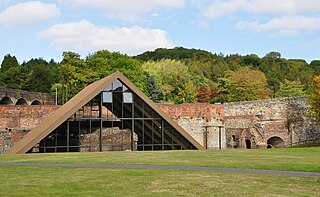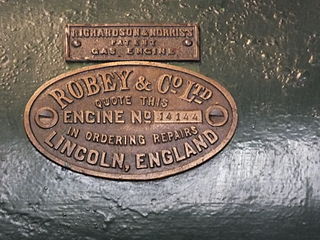
Richard Trevithick was a British inventor and mining engineer. The son of a mining captain, and born in the mining heartland of Cornwall, Trevithick was immersed in mining and engineering from an early age. He was an early pioneer of steam-powered road and rail transport, and his most significant contributions were the development of the first high-pressure steam engine and the first working railway steam locomotive. The world's first locomotive-hauled railway journey took place on 21 February 1804, when Trevithick's unnamed steam locomotive hauled a train along the tramway of the Penydarren Ironworks, in Merthyr Tydfil, Wales.

Coalbrookdale is a village in the Ironbridge Gorge in Shropshire, England, containing a settlement of great significance in the history of iron ore smelting. It lies within the civil parish called the Gorge.

Marshall, Sons & Co. was a British agricultural machinery manufacturer founded in 1848. The company was based in the Britannia Iron Works, Gainsborough, Lincolnshire. Early production was of steam engines and agricultural machinery. Later production included diesel tractors such as the Field Marshall, Track Marshall and former Leyland wheeled tractors.

Aveling and Porter was a British agricultural engine and steamroller manufacturer. Thomas Aveling and Richard Thomas Porter entered into partnership in 1862, and developed a steam engine three years later in 1865. By the early 1900s, the company had become the largest manufacturer of steamrollers in the world. The company used a rampant horse as its logo derived from the White Horse of Kent.

Johann Karl Friedrich August Borsig was a German businessman who founded the Borsig-Werke factory.
Haigh Foundry was an ironworks and foundry in Haigh, Lancashire, which was notable for the manufacture of early steam locomotives.

MÁVAG was the largest Hungarian rail vehicle producer. MÁVAG company was the second largest industrial enterprise after the Manfréd Weiss Steel and Metal Works in the Hungarian half of the Austro-Hungarian Monarchy. MÁVAG was the property of the Kingdom of Hungary. After World War II MÁVAG was nationalized, and "Királyi" ("Royal") was removed from its name.

Charles Burrell & Sons were builders of steam traction engines, agricultural machinery, steam lorries and steam tram engines. The company were based in Thetford, Norfolk and operated from the St Nicholas works on Minstergate and St Nicholas Street, some of which survives today.

A steam wagon is a steam-powered truck for carrying freight. It was the earliest form of lorry (truck) and came in two basic forms: overtype and undertype, the distinction being the position of the engine relative to the boiler. Manufacturers tended to concentrate on one form or the other.

Stothert & Pitt was a British engineering company founded in 1855 in Bath, England. It was the builder of various engineering products ranging from Dock cranes to construction plant and household cast iron items. It went out of business in 1989. The name and intellectual property became part of Clarke Chapman.
Markham & Co. was an ironworks and steelworks company near Chesterfield, Derbyshire, England.

Anna Valley is part of the village and parish of Upper Clatford, Hampshire, United Kingdom. The settlement is located approximately 1.0 mile (1.6 km) south-west of the market town of Andover.

The Etna Iron Works was a 19th-century ironworks and manufacturing plant for marine steam engines located in New York City. The Etna Works was a failing small business when purchased by ironmolder John Roach and three partners in 1852. Roach soon gained full ownership of the business and quickly transformed it into a successful general-purpose ironworks.

W & J Galloway and Sons was a British manufacturer of steam engines and boilers based in Manchester, England. The firm was established in 1835 as a partnership of two brothers, William and John Galloway. The partnership expanded to encompass their sons and in 1889 it was restructured as a limited liability company. It ceased trading in 1932.

James & Fred Howard of Britannia Ironworks, Bedford, later known simply as Howards, were one of the largest English makers of agricultural equipment, steam traction engines, and light railway equipment. At The Great Exhibition of 1851 they exhibited a range of horse-drawn implements. After World War I, Howards became part of AGE, Agricultural & General Engineers, along with many of the other British makers of similar machinery.

Losh, Wilson and Bell, later Bells, Goodman, then Bells, Lightfoot and finally Bell Brothers, was a leading Northeast England manufacturing company, founded in 1809 by the partners William Losh, Thomas Wilson, and Thomas Bell.

The Low Moor Ironworks was a wrought iron foundry established in 1791 in the village of Low Moor about 3 miles (4.8 km) south of Bradford in Yorkshire, England. The works were built to exploit the high-quality iron ore and low-sulphur coal found in the area. Low Moor made wrought iron products from 1801 until 1957 for export around the world. At one time it was the largest ironworks in Yorkshire, a major complex of mines, piles of coal and ore, kilns, blast furnaces, forges and slag heaps connected by railway lines. The surrounding countryside was littered with waste, and smoke from the furnaces and machinery blackened the sky. Today Low Moor is still industrial, but the pollution has been mostly eliminated.

Robey and Co. was an engineering company based in Lincoln, Lincolnshire, England which can be traced back to around 1849.

The Lithgow Blast Furnace is a heritage-listed former blast furnace and now park and visitor attraction at Inch Street, Lithgow, City of Lithgow, New South Wales, Australia. It was built from 1906 to 1907 by William Sandford Limited. It is also known as Eskbank Ironworks Blast Furnace site; Industrial Archaeological Site. The property is owned by Lithgow City Council. It was added to the New South Wales State Heritage Register on 2 April 1999.





















